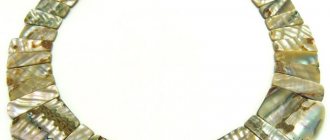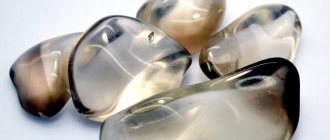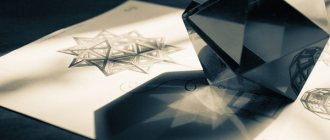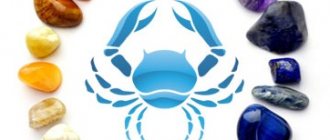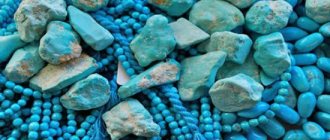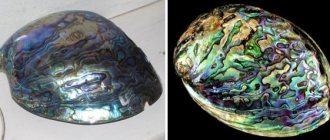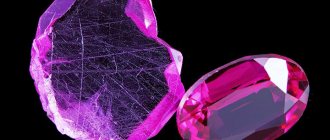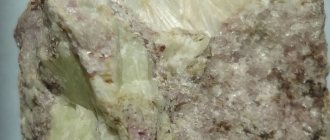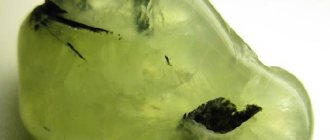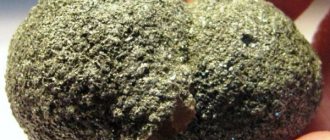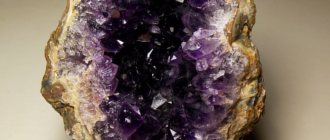Mother of pearl is a stone that has been known since ancient times. In fact, it is a calcareous shell of mollusks and other marine inhabitants. The stone has amazing shimmer and looks very attractive. In addition, it is characterized by unusual properties. Thanks to this, mother-of-pearl stones can be used to improve the quality of life.
Mother of pearl is a stone that is distinguished by amazing shimmer.
History and origin
Mother-of-pearl inlay is found in Egyptian pyramids; a seven-thousand-year-old necklace made of this mineral, made by Mesopotamian craftsmen, was found in modern Iraq.
Incredible stones of the “mother of pearls”
In the East, the favorite was the white variety of stone.
It was believed that mother of pearl is a mineral of such power that it can easily teach the owner to recognize people’s thoughts. No wonder the eccentric Roman dictator Nero ordered the walls of his residence to be covered with iridescent plates.
Aesculapians of the ancient world used the powder as an antiseptic for wounds. This was its main meaning for a person of that time, when countries were constantly at war with each other.
Medieval healers made pearl dust the basis of tinctures and potions. The mineral was used to decorate temple interiors and utensils. However, the stone played a cruel joke on many clergy in Europe. Having come up with the idea of selling weightless particles scraped from shells as “angel feathers,” they quickly became rich. After which they renounced their rank, becoming laymen.
A curiosity from the East captivated the Russian and European nobility at the turn of the 17th-18th centuries. Iridescent tabletops of dressing tables, snuff boxes, and boxes decorated boudoirs and offices.
Antique mother-of-pearl box
Maria Stuart assembled a complete set of mineral accessories. The Hermitage keeps the mother-of-pearl collection of the Russian empress Catherine the Great, hundreds of copies.
Many people identify mother-of-pearl with pearls. But pearls appear when a foreign object gets inside the pearl shell. If nothing penetrates the valves, the secretion produced by the mollusk grows on the walls of its shell. This forms an iridescent iridescent layer several millimeters thick. It's called mother of pearl.
Field
The sea offers humanity an infinite number of products with which it has been able to decorate both appearance and personal belongings since ancient times. One of the most beautiful products that the sea offers to people is mother of pearl. This is rainbow limestone that forms inside the shells of some mollusks.
High quality mother of pearl is produced all over the world: Indonesia, Polynesia, Australia, Djiboutia, Philippines, Madagascar.
In the Mediterranean, since ancient times, some types of mother-of-pearl have been mined for the manufacture of jewelry, figurines and other utensils.
Physicochemical characteristics
Mother of pearl, together with coral, amber and pearls, belongs to minerals of organic origin. The iridescence of the stone is created by a structure that refracts the sun's rays differently.
| Formula | CaCO3 |
| Color | White, gray, black, shades of pink, green, blue |
| Shine | Glass |
| Transparency | Opaque |
| Hardness | 2,5–4 |
| Cleavage | imperfect, very imperfect, or not observed at all |
| Kink | Uneven |
| Density | 2.7 g/cm3 |
Natural mother of pearl, unlike pearls, is not round.
Gemologists do not consider mother-of-pearl stones to be gems. But their aesthetic qualities make them equal.
Bracelet made of square plates of mother-of-pearl
In the sea, in the lake, in the river
Freshwater and marine shells may have an inner layer consisting of organic and inorganic substances. They are produced by the mollusk itself, living in the shell.
Inner mother-of-pearl layer of the pearl barley shell
Place of extraction
The mineral is not specifically sought for; it is not found in the mountains or underground. This is a pleasant and valuable addition to pearls that are mined in the seas or rivers.
Main mineral deposits:
- surroundings of the islands of Borneo and Sri Lanka;
- Persian Gulf and Red Sea;
- Philippine and Japanese archipelagos;
- Atlantic coast of North America.
Only the tropics supply the highest quality material. Cultivated or freshwater raw materials (northern Europe) are inferior in quality and price.
Modern technologies do not matter when extracting the mineral: shells are extracted by hand.
Mother of pearl shells – “mother of pearls”
Varieties and colors
Mother of pearl is created by marine or freshwater mollusks; it is transparent or impenetrable. The description of the mineral always contains clarification in this regard. Only marine specimens produce raw materials of different colors, shapes and sizes. The color of the stone is determined by the region of residence and the diet of the mollusk:
- white - a popular common type of mineral, created in the Indian Ocean by the "manila" shell;
- gray or black - rare large specimens, a product of the giant pinna mollusk;
- red is a product of an abalone shell;
- purple - the mother-of-pearl base of the venus mollusk is green or purple, but the output is always purple.
The most valuable type of stone is haliotis. She combines all the colors with a unique design. Durable, large (up to 20 cm), flexible. Created by a shell of the same name. The mineral is used for premium segment products.
Rare expensive colors of stone - blue, pink, black. The most affordable sea mineral in the yellow range is the most affordable.
Colored material is more expensive than pure white, cream or cream, so such specimens are painted.
The price includes multi-colored stones: grayish-green, bluish-white, pink mother-of-pearl with olive or black with an inky tint.
Almost all the material on the market is white freshwater mother of pearl
Strings of mother-of-pearl beads of different colors
What is mother of pearl
During its life, the oyster produces a secretion that protects it from pathogenic and traumatic agents. This substance coats the inner walls of the shell and is involved in the formation of pearls.
Mother of pearl refers to both the organic substance itself and the inner surface of the shell, covered with a mineral secretion. Shell fragments, as well as the pearls themselves, are used by jewelers to create accessories and jewelry.
A variety of colors and iridescent tints give the mineral a unique appearance and charm. Thanks to these features, gemstone products are highly valued among jewelers and collectors.
Varieties and colors
Like pearls, nacre can be either river or sea. However, this feature does not significantly affect the appearance of the stone. The properties of the water and the oyster itself are more important.
Mother of pearl has a layered structure, and each layer may differ from the previous one. Due to this, a specific shell color is formed. The stone itself has many shimmers and complex shades.
Colors may vary depending on lighting.
The following shell colors are more common:
- white;
- gray;
- silver;
- cream;
- pinkish;
- golden;
- copper;
- brownish;
- olive;
- black.
White mother-of-pearl is the most common type. Oysters that produce this pigment are the most common.
Rare and expensive varieties of stone include dark gems. More often, a similar color can be seen in marine representatives. Such minerals are distinguished by a richness of shades. In the light, dark colors glow green, purple and blue.
See a general review of the stone:
Medicinal properties
The healing properties of mother of pearl have been studied for centuries. Powder from it was sold in pharmacies in Medieval Europe.
Modern research has established that the healing qualities of the mineral affect the body in a complex manner:
- calm the nerves;
- cleanse blood vessels;
- restore the body exhausted by the disease;
- strengthen tone and immunity.
Mother of pearl is purchased by cosmetic corporations. Creams, tonics and emulsions with pearl powder rejuvenate the skin, whiten it, and remove age spots or freckles.
You can treat diseases beautifully using mineral jewelry. It is advisable to wear them closer to the problem area of the body:
- a brooch or beads eliminate cardiovascular problems;
- tiara or hairpin - migraine, headache;
- light earrings - ear diseases, hearing impairment.
Earrings made of milky mother-of-pearl
If cancer is suspected, black mother-of-pearl is worn. It also helps with diseases of the bones or respiratory system.
Magic properties
The magical qualities of mother-of-pearl are similar to pearls, but are less pronounced. People believed that the stone endowed the owner with health, luck, beauty, and wisdom. The mineral protects the home from evil spirits and prolongs the life of the owner. Mother-of-pearl jewelry makes the owner irresistible.
It has been established that the magical properties of colored mother-of-pearl vary:
- White. The gem is needed by everyone who is overcome by anxiety, stress, and self-doubt. It will attract pleasant novelty, joy and useful allies.
White mother of pearl beads - Pink. The embodiment of romantic feelings. A large curlicue shell in a prominent place will save the family hearth, attract money, and give peace of mind to household members. The easiest way to convey tender feelings is by giving a pink-pearl item. Will protect you from troubles on the road.
Earrings with pink sea mineral - Coffee cinnamon. A business attribute, suitable for workaholics or careerists. The stone will ensure the favor of management, productive work, and eliminate conflicts in the team.
Brown mineral beads - Black. The properties of this mother of pearl are valued by the occult community. If the owner manages to establish contact, the stone will make him a magician. It is said that the water in the black mineral cup becomes the elixir of life.
Black sea mineral pendants
The use of mother-of-pearl as an amulet protects against mental and physical negativity. The stone is especially useful for children against the evil eye.
An energetically friendly gem turns the owner into an optimist, striving to conquer new heights. However, prolonged “captivity” in a case or box weakens the magical properties of the stone and it becomes dull.
Frequently wearing jewelry with mother-of-pearl is beneficial for both the stone and the owner.
Who is suitable according to their zodiac sign?
Not all zodiac signs can use this romantic mineral.
For girls born under the sign of Cancer, he will help them pass exams, get married, and become a mother.
Leos need a green gem.
Green mineral beads
The stone will bring harmony and good health to Pisces, Aquarians will understand their calling.
In emotional Virgos and mentally vulnerable Geminis, mother-of-pearl will provoke depression to the point of a nervous breakdown.
Others can wear it periodically.
| Zodiac sign | Compatibility |
| Aries | + |
| Taurus | + |
| Twins | — |
| Cancer | +++ |
| a lion | + |
| Virgo | + |
| Scales | + |
| Scorpion | + |
| Sagittarius | + |
| Capricorn | + |
| Aquarius | +++ |
| Fish | +++ |
(“+++” – fits perfectly, “+” – can be worn, “-” – is strictly contraindicated)
Compatibility with other stones
Astrologers and esotericists have calculated that the following gems are in energetic harmony with the mineral of the water element, mother of pearl:
- aquamarine;
- selenite;
- opal;
- pearl;
- coral;
- hematite.
The combination of mother-of-pearl with “fiery”, transparent and pure stones: diamond, sapphire, ruby is contraindicated. Minerals destroy each other.
Gold vintage brooch with white mother-of-pearl and pearls
Where is it used?
In addition to the cosmetics industry, mother-of-pearl is in demand in jewelry and design. Whole shells or mineral plates are used, and even valuable pearl dust is not lost.
Treatment
Unlike pearls, the process of refining mother-of-pearl is multi-level. Performed by a team of high-class craftsmen:
- grinder;
- carver;
- polisher;
- molder;
- engraver.
Natural mother of pearl is fragile, so it is processed the old fashioned way, by hand. Nondescript grayish stones are treated with silver chloride, resulting in a noble dark material.
Mother of pearl thread
Jewelry
Products and jewelry with minerals occupy the middle price segment. Mother-of-pearl plates look best in a white or grayish frame (silver, gold or platinum).
The mineral is combined with gems similar in nature and qualities:
- coral;
- pearls;
- turquoise;
- malachite.
Upon request, they can create mother-of-pearl jewelry with high-class precious stones.
Products
Mother of pearl is of particular importance in Southeast Asia. Here everything is inlaid with the mineral: from cups to weapons. Iridescent boxes, partition screens, fans or national musical instruments become exquisite works of art and a welcome gift.
Tea set with mother-of-pearl mosaic inserts
The fashion for the mysterious mineral was happily picked up by the rest of the world. An interesting solution is a mosaic made of mother-of-pearl plates. The color scheme of the stone gives scope for creativity.
Areas of application
Used for making handicraft items.
Cutting parts from a shell for mother-of-pearl inlay
Stock of shells for making blanks
- Exclusive furniture, boxes, and musical instruments are decorated with mother-of-pearl plates.
- Artists can add pearlescent powder to their paints.
- In oriental bazaars and shops selling folk remedies for treatment, powder made from the precious material is in demand.
The stars speak
The only sign who is not recommended to wear mother-of-pearl jewelry is Gemini. Astrologers believe that the biomaterial will suppress the good character traits of the “twins” and will enhance the bad traits.
Mother of Pearl is a child of water, its likes and preferences belong to the signs of Water. Therefore, Scorpios, Pisces, and Cancers can count on the help of the stone at any time.
Jewelry made from the rainbow layer of shells will be useful for any sign of the Zodiac - for magical and medicinal purposes, and simply as decoration.
Is Mother of Pearl right for you?
Not really
Element
Water
Planets
Moon
Energy
Yin
How to spot a fake
Natural pearls are practically never mined, so the true mineral mother of pearl is rare.
Instead of stone, they offer imitations made of plastic, the fruits of the Peruvian bone palm, or tinted rejects.
The properties of natural mother-of-pearl help determine the origin:
- Structure. You can check by rubbing a sample over your lip or examining it under a microscope or magnifying glass. The natural mineral is porous, with irregularities or groove lines. The fake will be “ironed”.
- Strength. When exposed to a needle or nail, the natural stone will not be damaged, but a mark will remain on the plastic.
- Thickness. The layer of mother-of-pearl is only a couple of millimeters. Half-centimeter fragments of the mineral are used for elite products for the same salons. In a regular store, such an option means a fake.
- Fire. The heat of the flame causes natural mother-of-pearl to crack, discolor or tarnish. This is more of a theoretical method.
Beads, earrings or inlay plates are often created from pressed mother-of-pearl. That is, pearl grains are glued together and sent under the press. Since the base of the product is natural, the final product is not classified as a fake.
Earrings made of colored sea mineral
We check for authenticity
Visiting jewelry shops and stores often results in upset feelings. Many people fall for cunning tricks of sellers and purchase fakes.
Mother of pearl is also counterfeited. Usually, it is replaced with painted plastic, but there are also more sophisticated fakes (for example, made of glass).
How to check authenticity:
- Jewelry with artificial mother-of-pearl is easily scratched. You don't even need to use a knife to make the dough—a needle will be enough. But, of course, you will not be allowed to conduct such tests, so just take a closer look to see if there are any strong scratches on the earrings or bracelet.
- Natural mother of pearl has an uneven surface. Small folds and bulges are natural for him. Does the decoration have a completely flat surface? It is better to refuse to purchase it.
- A stone half a centimeter thick would be incredibly expensive. And it’s unlikely that such samples would be sold in an ordinary jewelry store. It’s quite another thing to see them in an expensive store, where the price tag is appropriate.
Of course, when buying jewelry, it is better to trust the opinion of a professional. But if this is not possible, you will have to make do with these tips. We hope you find them useful.
How to wear and care
The mineral is durable, but quickly becomes dirty and requires delicate handling.
Caring for mother-of-pearl products is simple:
- The mineral is cleaned with a soft cloth moistened with potato juice.
- The shine is restored by immersing the product in a warm soapy solution. The mineral is rubbed with a soft brush or cotton wool, covered with a layer of wet potato starch, and rinsed.
- Falls, air temperature fluctuations, and prolonged exposure to the sun are contraindicated for the gem.
- Natural stones crack and become cloudy from hot water, cosmetics or household chemicals.
- To make the mineral stronger, it is placed in water with sea salt.
Jewelry with a gem is removed before going to the beach, sauna or long summer walks. Put on after applying and absorbing cosmetics.
Mother-of-pearl jewelry is appropriate for the office, a romantic date or a party.
Stored separately from others, in a soft case or box away from heating devices.
Good time to buy
Products or jewelry made from mother-of-pearl are purchased on the 15th lunar day, when the stone seems to be “sleeping.” To recharge, it can be exposed to moonlight. Half a month later, on the 29th–30th day, the energy of the mineral is on the rise. Then for the first time they put on mother-of-pearl jewelry or begin to use a box, comb, screen, or other objects inlaid with a gem.
Sources and literature
- Mother of pearl // Great Russian Encyclopedia: [in 35 volumes] / ch. ed. Yu. S. Osipov. — M.: Great Russian Encyclopedia, 2004—2017.
- Pearl // Encyclopedic Dictionary of Brockhaus and Efron: in 86 volumes (82 volumes and 4 additional). - St. Petersburg, 1890-1907
- Nikitin A. M. Artistic paints and materials. Handbook / Section 3.11. Pearlescent pigments // M.: Infra-Engineering. — 2016 — 412 p.
- Practical guide by V. I. Marchenkov (“Jewelry,” p. 241)
- Mother of pearl // Commodity dictionary / I. A. Pugachev (editor-in-chief). - M.: State Publishing House of Trade Literature, 1959. - T. VI. - Stb. 856—857
- Mother of pearl // Great Soviet Encyclopedia: [in 30 volumes] / ch. ed. A. M. Prokhorov. — 3rd ed. - M.: Soviet Encyclopedia, 1969-1978
- Characteristics of mother-of-pearl on Wikipedia ru.wikipedia.org
5 / 5 ( 3 voices)
